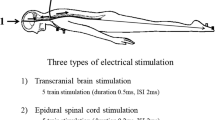Abstract
Somatosensory evoked potentials (SSEPs) were recorded on posterior tibial nerve stimulation during compression in 21 episodes of acute neurological decompression illness (DCI) involving 20 patients. A further two cases were monitored immediately after treatment only. The results were compared with previously published normal data from this laboratory and with recordings obtained during the compression of four normal volunteers. Compression had no effect on SSEPs in normal subjects. SSEP latency abnormalities were found in 17 of the episodes of DCI. An SSEP improvement at final recording was noted in 7 of the 11 episodes which were monitored during treatment and classified initially as neurophysiologically abnormal. SSEPs may assist in the diagnosis of DCI.
Similar content being viewed by others
References
Elliott DH, Moon RE (1993) Manifestations of the decompression disorders. In: Bennett PB, Elliott DH (eds) The physiology and medicine of diving. Saunders, London, pp 481–505
Murrison AW, Francis TJR (1991) An introduction to decompression illness. Br J Hosp Med 46:107–110
Allen A, Starr A, Nudleman K (1981) Assessment of sensory function in the operating room utilizing cerebral evoked potentials: a study of fifty-six surgically anesthetized patients. Clin Neurosurg 28:457–481
Haymaker W (1957) Decompression sickness. In: Lubarsch C, Henke F, Rossle R (eds) Handbuch der speziellen pathologischen Anatomie and Histologie. Nervensystem, vol XIII, part I. Springer, Berlin Heidelberg New York, pp 1600–1672
Palmer AC, Calder IM, Hughes JT (1987) Spinal cord degeneration in divers. Lancet II:1365–1366
Halliday AM, Wakefield GS (1963) Cerebral evoked potentials in patients with dissociated sensory loss. J Neurol Neurosurg Psychiatry 26:211–219
Taylor F (1898) A clinical lecture on diver's paralysis and lead paralysis. Clin J 12:1–6
Francis TJR, Pezeshkpour GH, Dutka AJ, Hallenbeck JM, Flynn ET (1988) Is there a role for the autochthonous bubble in the pathogenesis of spinal cord decompression sickness? J Neuropathol Exp Neurol 47:475–487
Heller R, Mager W, Schrotter H von (1900) Luftdruckerkrankungen mit besonderer Berücksichtigung der sogenannten Caissonkrankheit, vol 1 and 2. Holder, Vienna
Moon RE, Camporesi EM, Erwin CW (1987) Use of evoked potentials during acute dysbaric illness. In: Elliott DH, Halsey MJ (eds) Diagnostic techniques in diving neurology. Workshop report. Medical Research Council, London, pp 63–69
Overlock R, Dutka A, Farm F, Okamoto G, Suzuki D (1989) Somatosensory evoked potentials measured in divers with a history of spinal cord decompression sickness. Undersea Biomed Res [Suppl] 16:89
Yiannikas C, Beran R (1988) Somatosensory evoked potentials, electroencephalography and CT scans in the assessment of the neurological sequelae of decompression sickness. Clin Exp Neurol 25:91–96
Rivera JC (1964) Decompression sickness among divers: an analysis of 935 cases. Mil Med 129:314–334
Murrison AW, Glasspool E, Sedgwick EM (1993) Neurophysiological monitoring during the treatment of acute neurological decompression illness. J Electrophysiol Technol 19:97–105
Jasper HH (1958) The ten-twenty electrode system of the International Federation. Electroencephalogr Clin Neurophysiol 10:371–375
Katifi HA (1988) Dermatomal somatosensory evoked potentials in lumbosacral radiculopathy. MD thesis. University of Southampton
Katifi HA, Sedgwick EM (1986) Somatosensory evoked potentials from posterior tibial nerve and lumbo-sacral dermatomes. Electroencephalogr Clin Neurophysiol 65:249–259
Donchin E, Callaway E, Cooper R, Desmedt JE, Goff WR, Hillyard SA, Sutton S (1977) Publication criteria for studies of evoked potentials (EP) in man. Report of a committee. In: Desmedt JE (ed) Attention, voluntary contraction and event related cerebral potentials. Karger, Basel, pp 1–11
Mitchell P, Erwin CW, Camporesi EM, Moon RE, Goad R, Mebane Y, Stolp B, Bennett PB (1987) Latency and amplitude of somatosensory evoked potentials in normal subjects breathing air and oxygen at 1 and 2.8ATA. In: Bove AA, Backrach AJ, Greenbaum LJ (eds) Proceedings of the 9th International Symposium on Underwater and Hyperbaric Physiology. Undersea and Hyperbaric Medical Society, Bethesda, pp 1025–1030
Matthews WB, Read DJ, Pountney E (1979) Effect of raising body temperature on visual and somatosensory evoked potentials in patients with multiple sclerosis. J Neurol Neurosurg Psychiatry 42:250–255
Hardman JM, Beckman EL (1990) Pathogenesis of central nervous system decompression sickness. Undersea Biomed Res [Suppl] 17:95–96
Matthews WB, Wattam-Bell JRB, Pountney E (1982) Evoked potentials in the diagnosis of multiple sclerosis. A follow-up study. J Neurol Neurosurg Psychiatry 45:303–307
Author information
Authors and Affiliations
Rights and permissions
About this article
Cite this article
Murrison, A., Glasspool, E., Francis, J. et al. Somatosensory evoked potentials in acute neurological decompression illness. J Neurol 242, 669–676 (1995). https://doi.org/10.1007/BF00866918
Received:
Revised:
Accepted:
Issue Date:
DOI: https://doi.org/10.1007/BF00866918




